Cruise Ship Engineering: Material Selection, Design and Analysis
VerifiedAdded on 2023/06/10
|16
|2752
|95
Report
AI Summary
This report provides an in-depth analysis of the engineering considerations involved in cruise ship design, focusing primarily on material selection and the application of fundamental scientific principles. It begins by outlining the basic components and materials used in ship construction, emphasizing the importance of steel due to its favorable metallurgical properties. The report then delves into the application of Archimedes' principle to determine the ship's load-bearing capacity and buoyancy, explaining how the weight of the ship must equal the weight of the water it displaces. Further analysis includes comparing the elasticity and breaking points of different materials to justify the selection of steel, followed by an assessment of the energy requirements of the ship using D'Alembert's principle and the Energy Efficiency Design Index (EEDI). The report also examines the effects of temperature variations on solid materials and the concept of hysteresis in various material properties. Finally, it discusses the thermal efficiency of ship engines and its impact on the ship's performance, concluding with a practical application of Archimedes' principle to determine the maximum load-bearing capacity of the ship.

ENGINEERING SCIENCE PART 1
NAME OF THE STUDENT
NAME OF THE UNIVERSITY
AUTHOR NOTE
NAME OF THE STUDENT
NAME OF THE UNIVERSITY
AUTHOR NOTE
Paraphrase This Document
Need a fresh take? Get an instant paraphrase of this document with our AI Paraphraser

Introduction:
The basic components that are required to build a ship is same for all kinds of ships. The materials
that are required to build a ship are steels, aluminum, plastic, iron core and may more based on the
type and size of the ship. In this particular task the mechanical materials needed to build one Cruise
ship is provided along with an approximate design of the ship. All the mechanical stress, strain,
breaking stress of the materials are calculated using scientific methods that will allow long term
stability of the ship. The final chosen materials for building the ship is decided based on the
calculations and the results obtained in previous articles where similar kinds of ships were
manufactured.
The basic components that are required to build a ship is same for all kinds of ships. The materials
that are required to build a ship are steels, aluminum, plastic, iron core and may more based on the
type and size of the ship. In this particular task the mechanical materials needed to build one Cruise
ship is provided along with an approximate design of the ship. All the mechanical stress, strain,
breaking stress of the materials are calculated using scientific methods that will allow long term
stability of the ship. The final chosen materials for building the ship is decided based on the
calculations and the results obtained in previous articles where similar kinds of ships were
manufactured.
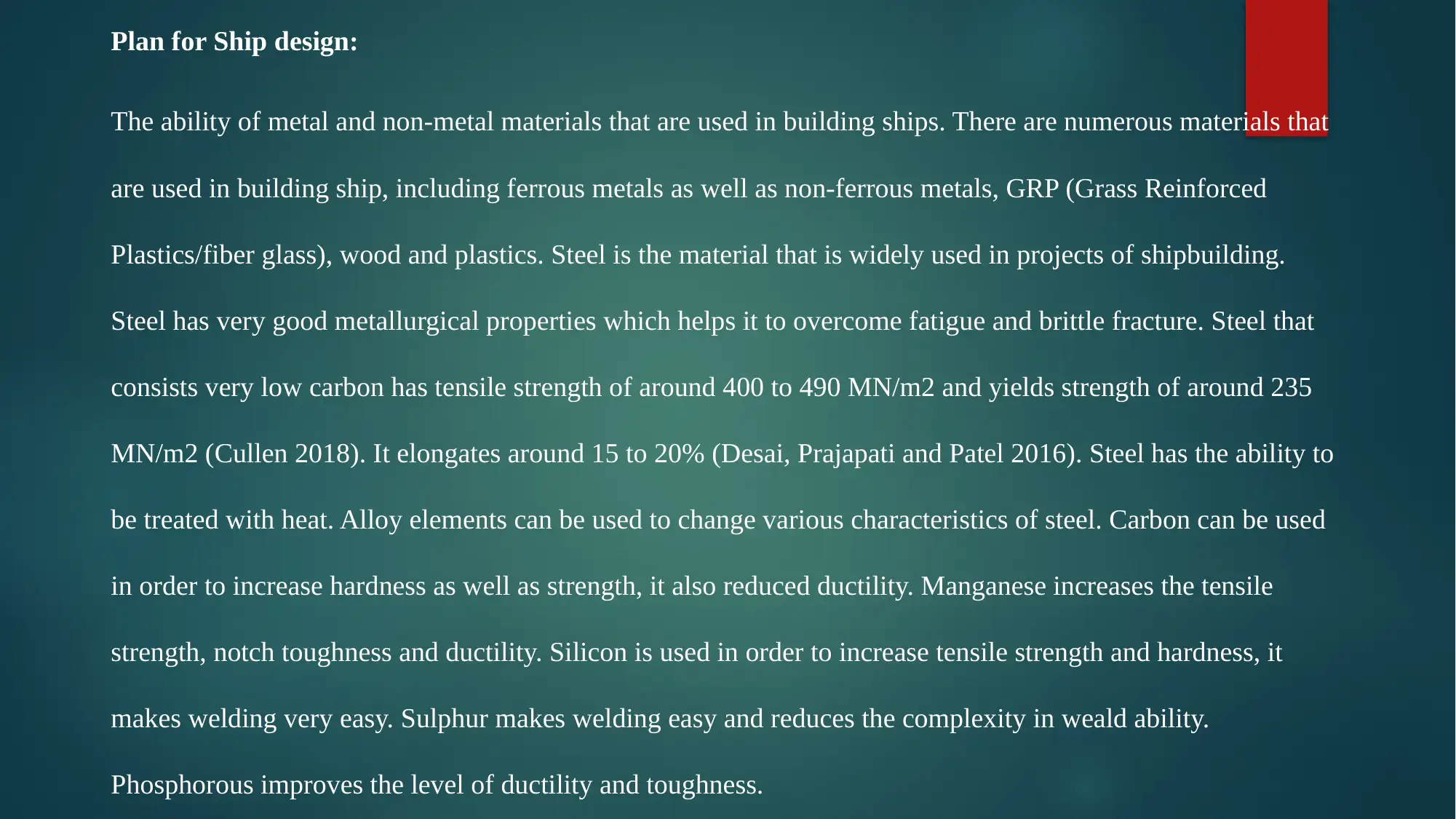
Plan for Ship design:
The ability of metal and non-metal materials that are used in building ships. There are numerous materials that
are used in building ship, including ferrous metals as well as non-ferrous metals, GRP (Grass Reinforced
Plastics/fiber glass), wood and plastics. Steel is the material that is widely used in projects of shipbuilding.
Steel has very good metallurgical properties which helps it to overcome fatigue and brittle fracture. Steel that
consists very low carbon has tensile strength of around 400 to 490 MN/m2 and yields strength of around 235
MN/m2 (Cullen 2018). It elongates around 15 to 20% (Desai, Prajapati and Patel 2016). Steel has the ability to
be treated with heat. Alloy elements can be used to change various characteristics of steel. Carbon can be used
in order to increase hardness as well as strength, it also reduced ductility. Manganese increases the tensile
strength, notch toughness and ductility. Silicon is used in order to increase tensile strength and hardness, it
makes welding very easy. Sulphur makes welding easy and reduces the complexity in weald ability.
Phosphorous improves the level of ductility and toughness.
The ability of metal and non-metal materials that are used in building ships. There are numerous materials that
are used in building ship, including ferrous metals as well as non-ferrous metals, GRP (Grass Reinforced
Plastics/fiber glass), wood and plastics. Steel is the material that is widely used in projects of shipbuilding.
Steel has very good metallurgical properties which helps it to overcome fatigue and brittle fracture. Steel that
consists very low carbon has tensile strength of around 400 to 490 MN/m2 and yields strength of around 235
MN/m2 (Cullen 2018). It elongates around 15 to 20% (Desai, Prajapati and Patel 2016). Steel has the ability to
be treated with heat. Alloy elements can be used to change various characteristics of steel. Carbon can be used
in order to increase hardness as well as strength, it also reduced ductility. Manganese increases the tensile
strength, notch toughness and ductility. Silicon is used in order to increase tensile strength and hardness, it
makes welding very easy. Sulphur makes welding easy and reduces the complexity in weald ability.
Phosphorous improves the level of ductility and toughness.
⊘ This is a preview!⊘
Do you want full access?
Subscribe today to unlock all pages.

Trusted by 1+ million students worldwide
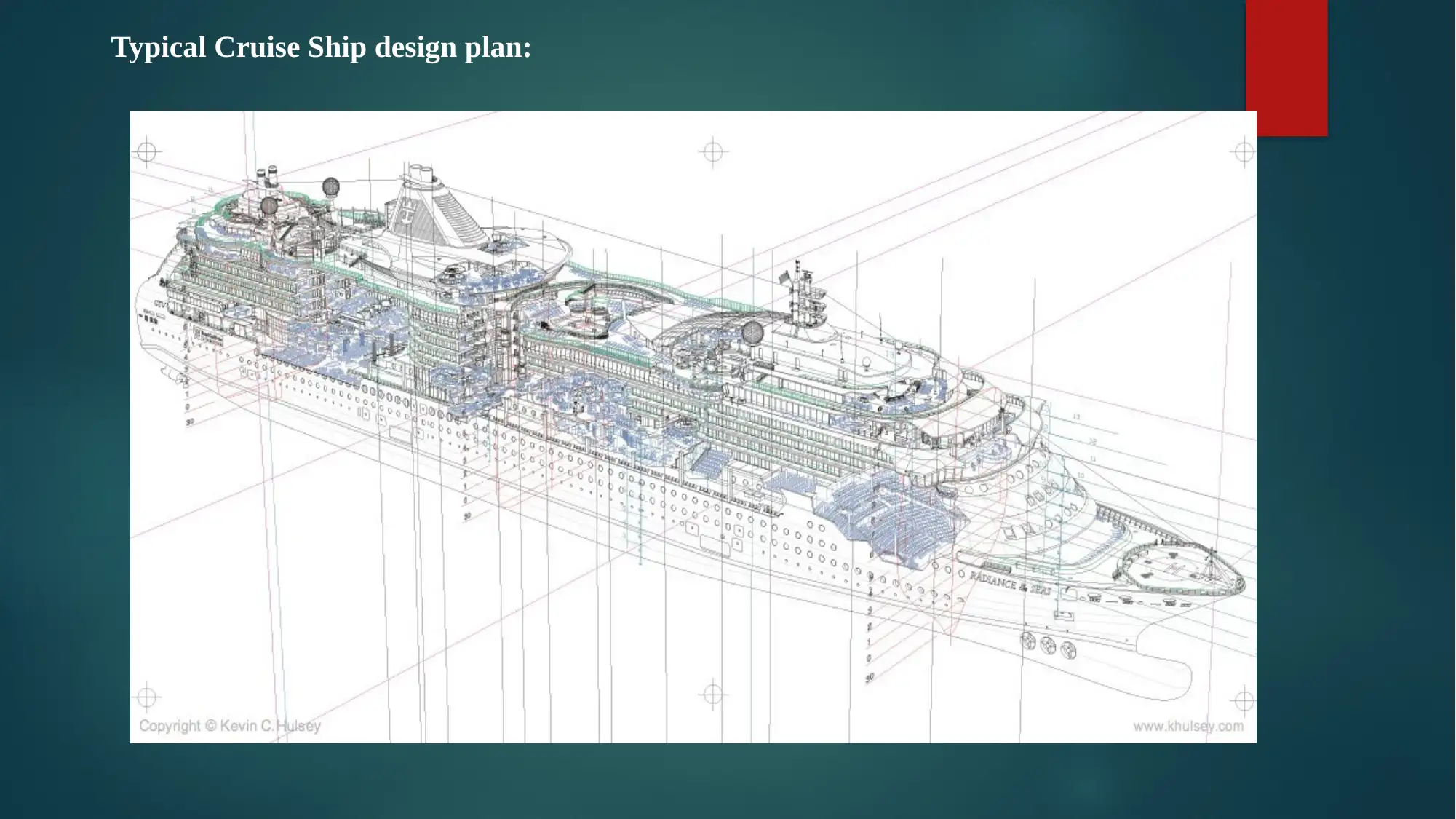
Typical Cruise Ship design plan:
Paraphrase This Document
Need a fresh take? Get an instant paraphrase of this document with our AI Paraphraser
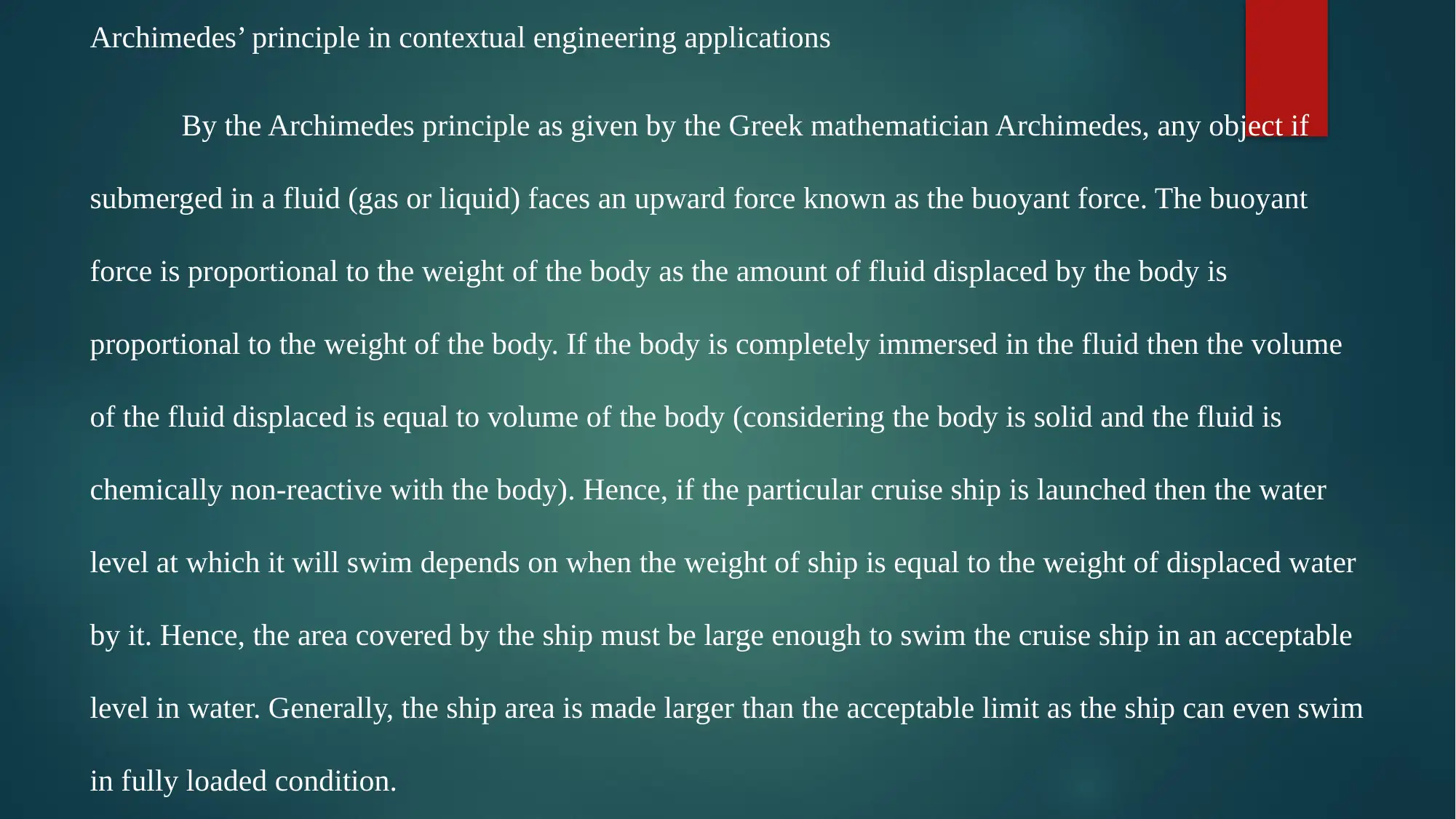
Archimedes’ principle in contextual engineering applications
By the Archimedes principle as given by the Greek mathematician Archimedes, any object if
submerged in a fluid (gas or liquid) faces an upward force known as the buoyant force. The buoyant
force is proportional to the weight of the body as the amount of fluid displaced by the body is
proportional to the weight of the body. If the body is completely immersed in the fluid then the volume
of the fluid displaced is equal to volume of the body (considering the body is solid and the fluid is
chemically non-reactive with the body). Hence, if the particular cruise ship is launched then the water
level at which it will swim depends on when the weight of ship is equal to the weight of displaced water
by it. Hence, the area covered by the ship must be large enough to swim the cruise ship in an acceptable
level in water. Generally, the ship area is made larger than the acceptable limit as the ship can even swim
in fully loaded condition.
By the Archimedes principle as given by the Greek mathematician Archimedes, any object if
submerged in a fluid (gas or liquid) faces an upward force known as the buoyant force. The buoyant
force is proportional to the weight of the body as the amount of fluid displaced by the body is
proportional to the weight of the body. If the body is completely immersed in the fluid then the volume
of the fluid displaced is equal to volume of the body (considering the body is solid and the fluid is
chemically non-reactive with the body). Hence, if the particular cruise ship is launched then the water
level at which it will swim depends on when the weight of ship is equal to the weight of displaced water
by it. Hence, the area covered by the ship must be large enough to swim the cruise ship in an acceptable
level in water. Generally, the ship area is made larger than the acceptable limit as the ship can even swim
in fully loaded condition.
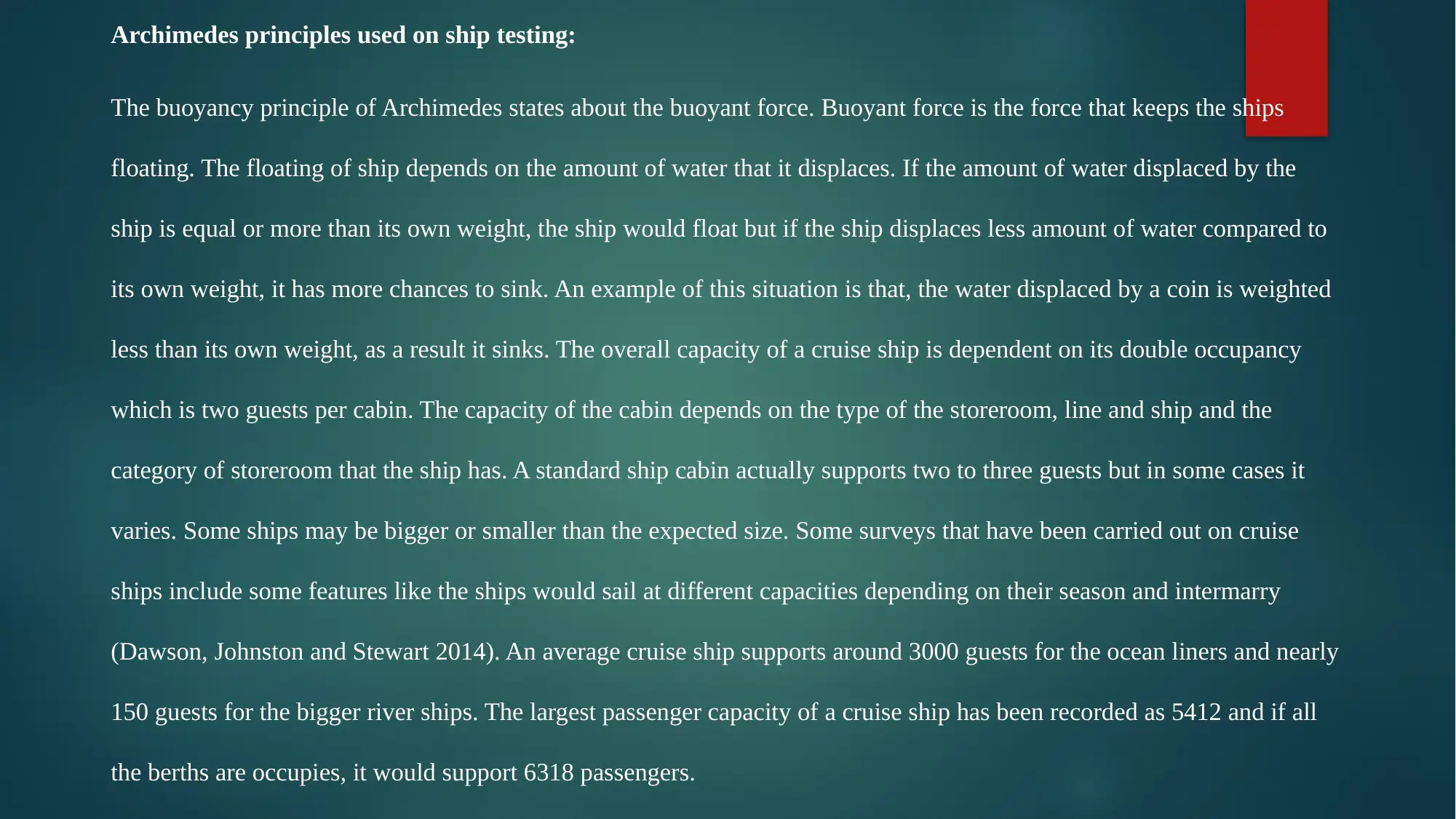
Archimedes principles used on ship testing:
The buoyancy principle of Archimedes states about the buoyant force. Buoyant force is the force that keeps the ships
floating. The floating of ship depends on the amount of water that it displaces. If the amount of water displaced by the
ship is equal or more than its own weight, the ship would float but if the ship displaces less amount of water compared to
its own weight, it has more chances to sink. An example of this situation is that, the water displaced by a coin is weighted
less than its own weight, as a result it sinks. The overall capacity of a cruise ship is dependent on its double occupancy
which is two guests per cabin. The capacity of the cabin depends on the type of the storeroom, line and ship and the
category of storeroom that the ship has. A standard ship cabin actually supports two to three guests but in some cases it
varies. Some ships may be bigger or smaller than the expected size. Some surveys that have been carried out on cruise
ships include some features like the ships would sail at different capacities depending on their season and intermarry
(Dawson, Johnston and Stewart 2014). An average cruise ship supports around 3000 guests for the ocean liners and nearly
150 guests for the bigger river ships. The largest passenger capacity of a cruise ship has been recorded as 5412 and if all
the berths are occupies, it would support 6318 passengers.
The buoyancy principle of Archimedes states about the buoyant force. Buoyant force is the force that keeps the ships
floating. The floating of ship depends on the amount of water that it displaces. If the amount of water displaced by the
ship is equal or more than its own weight, the ship would float but if the ship displaces less amount of water compared to
its own weight, it has more chances to sink. An example of this situation is that, the water displaced by a coin is weighted
less than its own weight, as a result it sinks. The overall capacity of a cruise ship is dependent on its double occupancy
which is two guests per cabin. The capacity of the cabin depends on the type of the storeroom, line and ship and the
category of storeroom that the ship has. A standard ship cabin actually supports two to three guests but in some cases it
varies. Some ships may be bigger or smaller than the expected size. Some surveys that have been carried out on cruise
ships include some features like the ships would sail at different capacities depending on their season and intermarry
(Dawson, Johnston and Stewart 2014). An average cruise ship supports around 3000 guests for the ocean liners and nearly
150 guests for the bigger river ships. The largest passenger capacity of a cruise ship has been recorded as 5412 and if all
the berths are occupies, it would support 6318 passengers.
⊘ This is a preview!⊘
Do you want full access?
Subscribe today to unlock all pages.

Trusted by 1+ million students worldwide
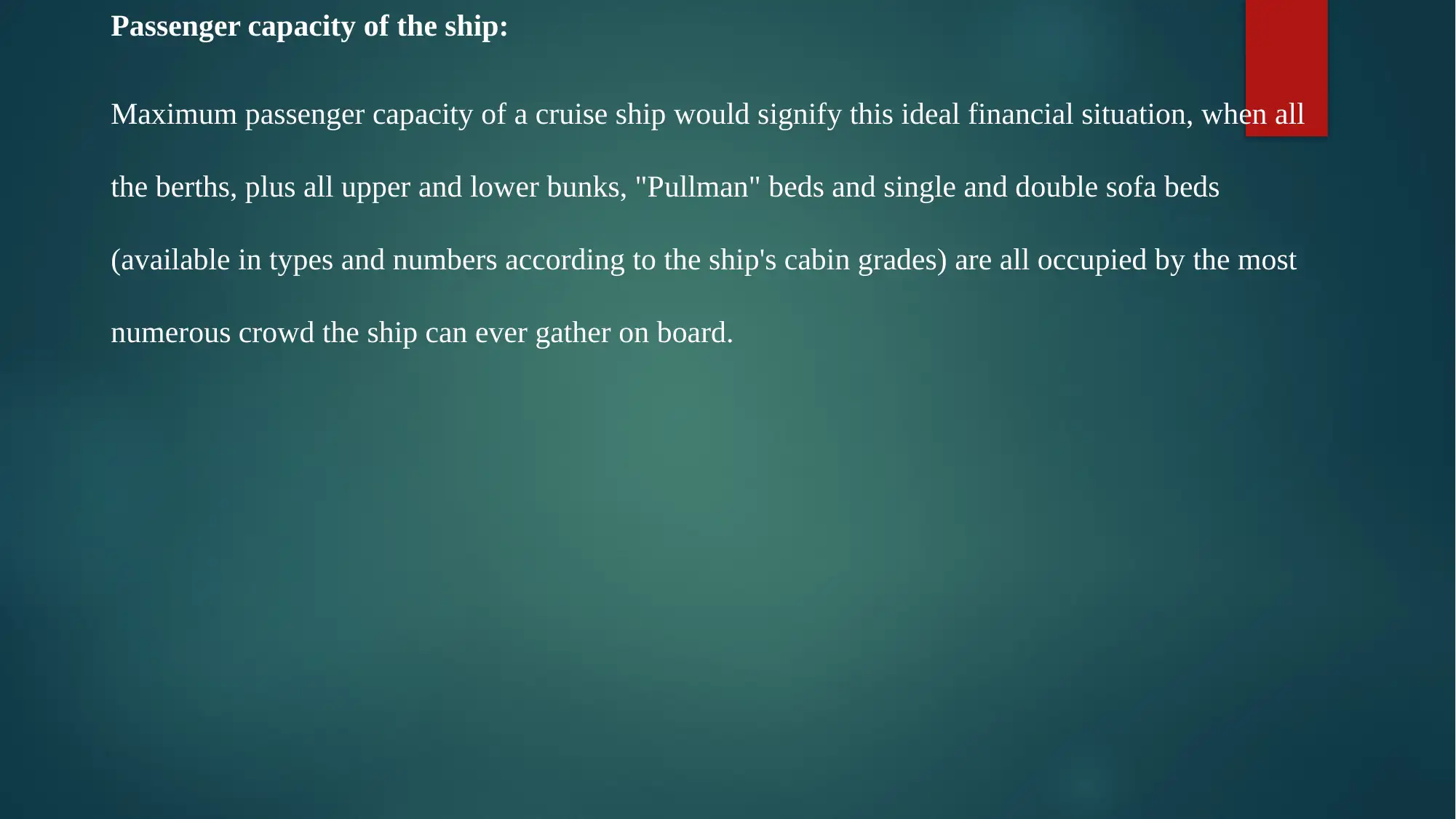
Passenger capacity of the ship:
Maximum passenger capacity of a cruise ship would signify this ideal financial situation, when all
the berths, plus all upper and lower bunks, "Pullman" beds and single and double sofa beds
(available in types and numbers according to the ship's cabin grades) are all occupied by the most
numerous crowd the ship can ever gather on board.
Maximum passenger capacity of a cruise ship would signify this ideal financial situation, when all
the berths, plus all upper and lower bunks, "Pullman" beds and single and double sofa beds
(available in types and numbers according to the ship's cabin grades) are all occupied by the most
numerous crowd the ship can ever gather on board.
Paraphrase This Document
Need a fresh take? Get an instant paraphrase of this document with our AI Paraphraser

Comparing the elasticity and breaking point of materials and choose the most suitable materials:
Elasticity of an object is the ability of an object to come back to its original size when a force is applied
to it and its shape has been changed. This can be expressed by using the ratio of stress that has been
applied per Square Pascal’s or inch to the strain. Iron can be defined as a basic element but is available
at various grades, steel is available in numerous allowed chemistry’s. At a particular room temperature
the elastic modules of various siren grades ranges from 10 – 24 x 10^6 psi whereas the modulus of
various steel alloys range from 28 – 30 x 10^6 psi. In case the Young modulus of a metal is greater, it is
stiffer (Stoop et al. 2015). This proves that iron is more elastic than steel. Still is stiffer compared to
Iron. The breaking point of iron is more than compared to steel. Hence using steel is a better option
while building a ship.
Elasticity of an object is the ability of an object to come back to its original size when a force is applied
to it and its shape has been changed. This can be expressed by using the ratio of stress that has been
applied per Square Pascal’s or inch to the strain. Iron can be defined as a basic element but is available
at various grades, steel is available in numerous allowed chemistry’s. At a particular room temperature
the elastic modules of various siren grades ranges from 10 – 24 x 10^6 psi whereas the modulus of
various steel alloys range from 28 – 30 x 10^6 psi. In case the Young modulus of a metal is greater, it is
stiffer (Stoop et al. 2015). This proves that iron is more elastic than steel. Still is stiffer compared to
Iron. The breaking point of iron is more than compared to steel. Hence using steel is a better option
while building a ship.
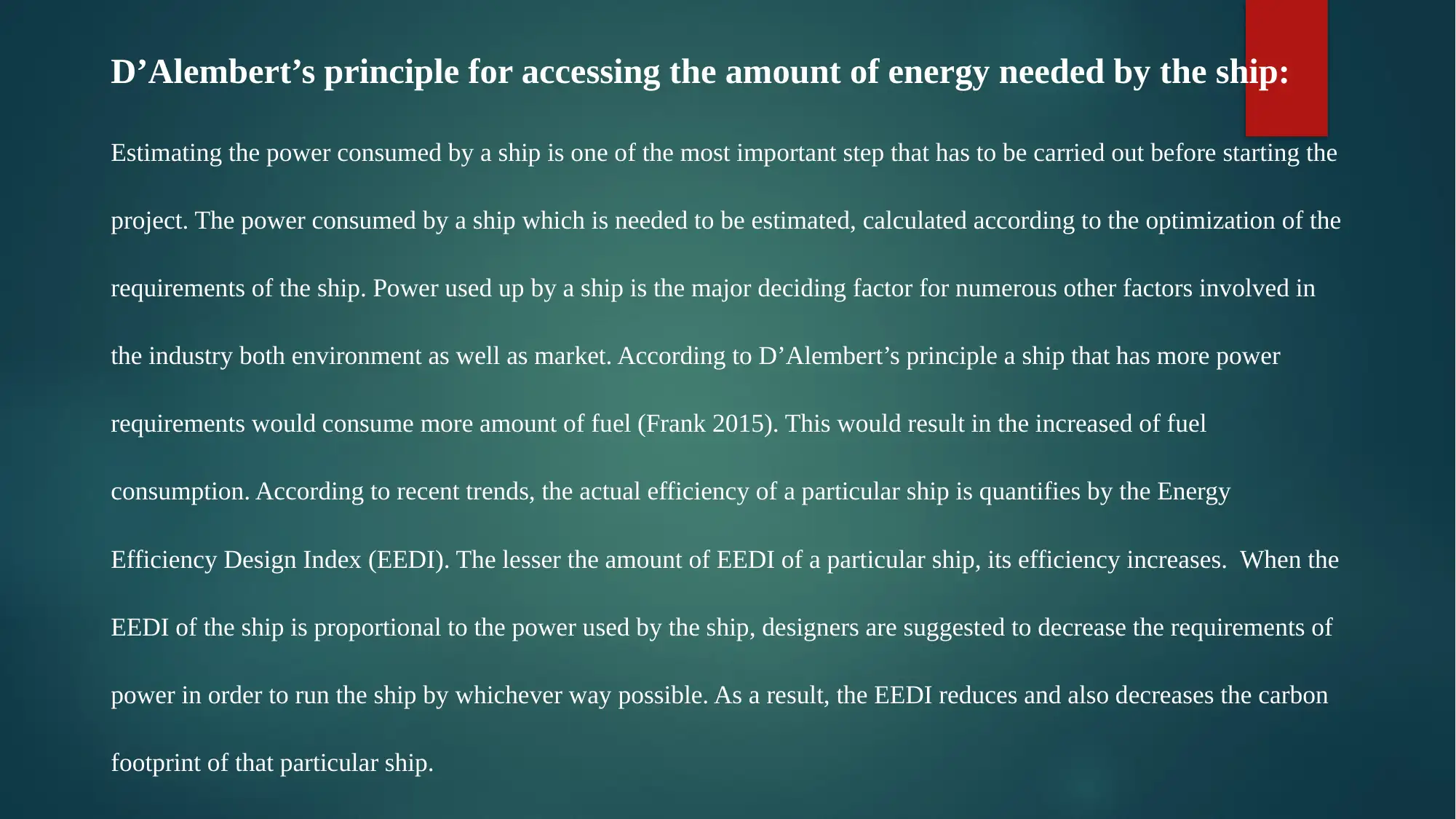
D’Alembert’s principle for accessing the amount of energy needed by the ship:
Estimating the power consumed by a ship is one of the most important step that has to be carried out before starting the
project. The power consumed by a ship which is needed to be estimated, calculated according to the optimization of the
requirements of the ship. Power used up by a ship is the major deciding factor for numerous other factors involved in
the industry both environment as well as market. According to D’Alembert’s principle a ship that has more power
requirements would consume more amount of fuel (Frank 2015). This would result in the increased of fuel
consumption. According to recent trends, the actual efficiency of a particular ship is quantifies by the Energy
Efficiency Design Index (EEDI). The lesser the amount of EEDI of a particular ship, its efficiency increases. When the
EEDI of the ship is proportional to the power used by the ship, designers are suggested to decrease the requirements of
power in order to run the ship by whichever way possible. As a result, the EEDI reduces and also decreases the carbon
footprint of that particular ship.
Estimating the power consumed by a ship is one of the most important step that has to be carried out before starting the
project. The power consumed by a ship which is needed to be estimated, calculated according to the optimization of the
requirements of the ship. Power used up by a ship is the major deciding factor for numerous other factors involved in
the industry both environment as well as market. According to D’Alembert’s principle a ship that has more power
requirements would consume more amount of fuel (Frank 2015). This would result in the increased of fuel
consumption. According to recent trends, the actual efficiency of a particular ship is quantifies by the Energy
Efficiency Design Index (EEDI). The lesser the amount of EEDI of a particular ship, its efficiency increases. When the
EEDI of the ship is proportional to the power used by the ship, designers are suggested to decrease the requirements of
power in order to run the ship by whichever way possible. As a result, the EEDI reduces and also decreases the carbon
footprint of that particular ship.
⊘ This is a preview!⊘
Do you want full access?
Subscribe today to unlock all pages.

Trusted by 1+ million students worldwide
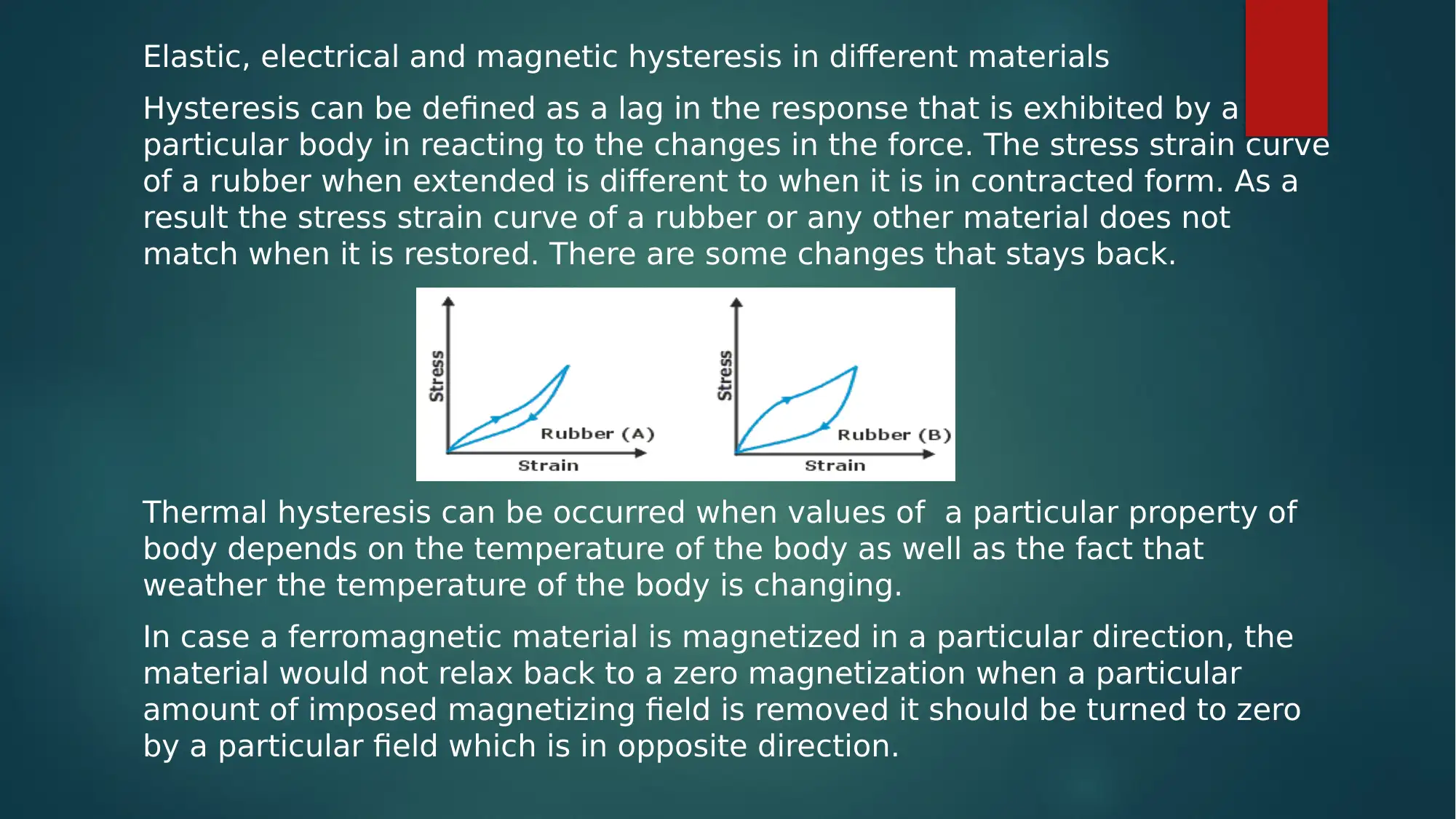
Elastic, electrical and magnetic hysteresis in different materials
Hysteresis can be defined as a lag in the response that is exhibited by a
particular body in reacting to the changes in the force. The stress strain curve
of a rubber when extended is different to when it is in contracted form. As a
result the stress strain curve of a rubber or any other material does not
match when it is restored. There are some changes that stays back.
Thermal hysteresis can be occurred when values of a particular property of
body depends on the temperature of the body as well as the fact that
weather the temperature of the body is changing.
In case a ferromagnetic material is magnetized in a particular direction, the
material would not relax back to a zero magnetization when a particular
amount of imposed magnetizing field is removed it should be turned to zero
by a particular field which is in opposite direction.
Hysteresis can be defined as a lag in the response that is exhibited by a
particular body in reacting to the changes in the force. The stress strain curve
of a rubber when extended is different to when it is in contracted form. As a
result the stress strain curve of a rubber or any other material does not
match when it is restored. There are some changes that stays back.
Thermal hysteresis can be occurred when values of a particular property of
body depends on the temperature of the body as well as the fact that
weather the temperature of the body is changing.
In case a ferromagnetic material is magnetized in a particular direction, the
material would not relax back to a zero magnetization when a particular
amount of imposed magnetizing field is removed it should be turned to zero
by a particular field which is in opposite direction.
Paraphrase This Document
Need a fresh take? Get an instant paraphrase of this document with our AI Paraphraser

The changes in thermal efficiency of a heat transfer process might
affect the behavioral characteristics of a mechanical system
Thermal efficiency can be defined as the engines as well as devices that are
utilized in order to convert energy in a form of heat into work. Thermal
efficiency is an efficiency of a particular cycle from a point of view of
thermodynamics. Hence, if the thermal efficiency is increased then the output
power from the engine also increases and hence in the ship engine will be able
to create more force in the movement through water with same amount of
energy input. These may cause problem while changing direction of the ship as
in the shallow water like near to the ports, the ship may impact with port
barriers. Conversely, if the thermal efficiency of the ship engine is decreased
then accelerating the ship in opposite of wind direction becomes difficult or
other problems may be created. Hence, it is necessary to adjust the thermal
efficiency of the ship engine such that a moderate performance can be
obtained. Typically, in a cruise ship medium speed four stroke engines are
used which has the thermal efficiency ranges from 73 to 81 percent.
affect the behavioral characteristics of a mechanical system
Thermal efficiency can be defined as the engines as well as devices that are
utilized in order to convert energy in a form of heat into work. Thermal
efficiency is an efficiency of a particular cycle from a point of view of
thermodynamics. Hence, if the thermal efficiency is increased then the output
power from the engine also increases and hence in the ship engine will be able
to create more force in the movement through water with same amount of
energy input. These may cause problem while changing direction of the ship as
in the shallow water like near to the ports, the ship may impact with port
barriers. Conversely, if the thermal efficiency of the ship engine is decreased
then accelerating the ship in opposite of wind direction becomes difficult or
other problems may be created. Hence, it is necessary to adjust the thermal
efficiency of the ship engine such that a moderate performance can be
obtained. Typically, in a cruise ship medium speed four stroke engines are
used which has the thermal efficiency ranges from 73 to 81 percent.

Task 1:Archimedes principle to determine maximum load bearing capacity of ship:
Ships and boats are the perfect example of how science can be used to solve simple problems. Archimedes proposed a
principle that is now known as “Archimedes principle” which states that the when any object is resting on or in water, it
experiences an upward force known as buoyant force that is equal to the weight of water. This amount of water is pushed
up by the object. As a result, the body floats. According to the principle, if the weight of the body is equal or less than the
amount of water displaced by it, the body would float, but if the weight of the body is more than the amount of water is
displaced, the body would sink (Zheng et al. 2016). This proves that the buoyant force of a body helps it to sink or float.
All this explains why the weight of a ship (and its contents) is usually called its displacement: if the ocean were a bowl of
water filled right to the brim, a ship's displacement is the weight of water that would spill over the edge when the ship was
launched. The USS Enterprise in our top photo has a displacement of about 75,000 tons unloaded or 95,000 tons with a full
load, when it sits somewhat lower in the water. Because freshwater is less dense than saltwater, the same ship will sit lower
in a river (or an estuary—which has a mixture of freshwater and saltwater) than in the sea.
Ships and boats are the perfect example of how science can be used to solve simple problems. Archimedes proposed a
principle that is now known as “Archimedes principle” which states that the when any object is resting on or in water, it
experiences an upward force known as buoyant force that is equal to the weight of water. This amount of water is pushed
up by the object. As a result, the body floats. According to the principle, if the weight of the body is equal or less than the
amount of water displaced by it, the body would float, but if the weight of the body is more than the amount of water is
displaced, the body would sink (Zheng et al. 2016). This proves that the buoyant force of a body helps it to sink or float.
All this explains why the weight of a ship (and its contents) is usually called its displacement: if the ocean were a bowl of
water filled right to the brim, a ship's displacement is the weight of water that would spill over the edge when the ship was
launched. The USS Enterprise in our top photo has a displacement of about 75,000 tons unloaded or 95,000 tons with a full
load, when it sits somewhat lower in the water. Because freshwater is less dense than saltwater, the same ship will sit lower
in a river (or an estuary—which has a mixture of freshwater and saltwater) than in the sea.
⊘ This is a preview!⊘
Do you want full access?
Subscribe today to unlock all pages.

Trusted by 1+ million students worldwide
1 out of 16
Your All-in-One AI-Powered Toolkit for Academic Success.
+13062052269
info@desklib.com
Available 24*7 on WhatsApp / Email
![[object Object]](/_next/static/media/star-bottom.7253800d.svg)
Unlock your academic potential
Copyright © 2020–2025 A2Z Services. All Rights Reserved. Developed and managed by ZUCOL.


